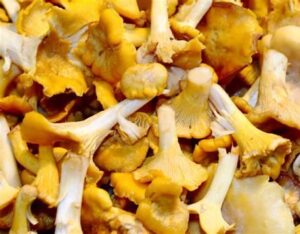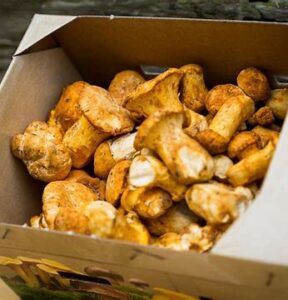Contents
hide
Description of winter chanterelle uk

how to identify winter chanterelle uk
Found in both coniferous and deciduous woodlands. Between August and December, the Winter Chanterelle. Or Yellowlegs Mushroom, is a smaller relative of the Golden Chanterelle. And as such, has a reputation for being an extremely tasty culinary mushroom. As one of it’s common names suggests, the Winter Chanterelle has a great ability to withstand the cold, and can even survive the first frosts. This makes it a true winter mushroom that can be found thriving as late as November and even December. It is, however, a true master of disguise! The topside of it’s brown, depresssed, and pretty unassuming cap, is the perfect camouflage amongst the fallen autumn leaves and can make it very difficult to spot. Underneath the cap however is a bright yellow stem that is hollow and sometimes brittle, that often develops a deep vertical depression that gives it the appearance of a pair of yellow legs.
where to find winter chanterelles uk
This mushroom is generally uncommon in the UK, but when a patch is found, it tends to be quite large, sometimes with several hundred fruiting bodies all in one place. Like the Golden Chanterelle, these mushrooms have forked folds rather than gills, which run partway down the stem. The flesh is yellow-brown with a strong mushroom aroma. They are considered a choice edible, with a strong peppery taste similar to chanterelles, but lacking the sweeter apricot notes. As such, they are great in a range of recipes such as soups and stews, omelettes, or cooked on their own on toast.
Arthur likes the taste of these these mushrooms and knows them by their common name Yellowlegs. He thinks their little legs are cute. Their hollow stems do have a tendency to snap when he harvests them, however, often leading to a basket filled only with caps!
After a stupidly dry September and a stupidly warm October, the weather has finally returned to something resembling normal, and the fungi are now also back to something resembling normal. And in November, that means a riot of spectacular colour. It’s as if the fungi are competing with the deciduous trees: “So you think you’re putting on a bit of a show, do you? Well, see what we can do!” With the exception of some very large and rather ancient (but still edible) chanterelles and hedgehogs, all the species in this basket are typical November species. Well, the prince and the blusher can appear at any time from late summer right through until now, but the rest are late season specialists.
winter chanterelle price
The winter chanterelles were a couple of weeks later than normal and are only just coming through strongly in the last few days, those are the first decent crop of blewits I’ve seen south of Northamptonshire this year, there’s a solitary trooping funnel in there and a couple of bay boletes (not a good year for either of those two species, which are both normally abundant in November). The pistachio-coloured orange and green things are saffron milkcaps, but even their rather striking colour scheme cannot compete with the most beautiful of all the edible fungi: the waxcaps (snowy, crimson, scarlet and golden).
I am expecting the next fortnight to be very good for fungi, after the main part of the season was disappointing at best, and largely dismal.

When the days have got shorter and the wind and rain have chased the fair-weather foragers back to their cosy living rooms, when the chanterelles have all been picked and any penny buns still standing are just hollow, grub-filled shells, when the deciduous trees have dropped most of their leaves and the mainstream modern world has turned the central heating on and is looking forward to Christmas…is mushroom season over? Hell, no it isn’t!
White Saddle (Helvella crispa) having a storming 2013. These usually turn up as singletons, but have been trooping in large numbers this year.
I nearly didn’t post this. I sat in the bath for a while and mulled it over. Do I really want to tell people this? Wouldn’t it be better just to keep quiet about it and post something about what an extraordinary year it has been for the strange, recently-declared-toxic White Saddle (Helvella crispa) instead? But then I concluded that not enough people read my blog to make any significant impact on the greatest fungal bounty the British countryside has to offer, especially since it involves people trudging around in the mud in search of something that most of them probably wouldn’t notice if it was right in front of them. And yet it ranks right up there among the best of the edible wild fungi and in a good year it fruits in such wild abundance that it would take an army of foragers to pick even half of them.
Now that mushroom foraging has really taken off in the UK it is not so easy to find Chanterelles (Cantherellus cibarius). They are, after all, bright yellow-orange and can be spotted from 40 metres if your vision is any good. I mean…there’s not that many brightly coloured objects scattered around on the woodland floor and everybody who has ever taken an interest in wild fungi knows what a chanterelle looks like. Plus they grow when you can still go mushrooming in a T-shirt. Far fewer people ever go looking for their late-season cousins, regardless of the fact that they outnumber the apricot-scented chanterelle by a factor of at least a thousand.
Winter Chanterelle (Craterellus tubaeformis). Early November 2013.
I am talking, of course, about Craterellus tubaeformis, otherwise known as the Winter Chanterelle, Trumpet Chanterelle or Yellowleg (or unhelpfully and confusingly called a Chanterelle, as it is in France, by people who also call Chanterelles by the French name “Girolle”). They are the sort of thing you probably wouldn’t notice at all unless you were looking for them. They are grey-brown, rather ragged and very well camouflaged. They also like to grow under bracken in inaccessible places. However, if you do happen to spot one then you stand a very good chance of finding as many more of them as you have the time and inclination to pick, and that is especially true right now. 2013 has been a vintage year for the whole of the Cantherellaceae family, so it comes as no surprise that it is proving to be a vintage year for C. tubaeformis.
What do you do with them (winter chanterelle uk)?
Well, first you have to take them home and carefully clean them. This requires the removal of the stem bases (if you weren’t sensible/patient enough to do that before you put them in your basket), then the use of a brush or nimble fingers to get rid of pine needles and bits of bracken. You’ll also need to tear open the bigger ones because they tend to accumulate debris and small animals inside their tubular stems. They have a taste which is both strong and delicate. Not overpowering, but enough to impart a lovely flavour to anything you might cook them with which isn’t already overpoweringly strong-tasting. They make a great addition to spaghetti bolognese, but if you want to try something a bit more adventurous then I can heartily recommend the wild mushroom and leek tart posted on our sister site Charmed Pot, which would work perfectly well with 100% Winter Chanterelles, although there are still Hedgehog Mushrooms (Hydnum repandum) about.
Winter chanterelles in abundance. These were picked on the first day I had a customer fail to turn up for a foraging session. And it was at a location chosen by himself! Bad move.
As for identification problems, there isn’t much you could get these mixed up with. Maybe some of the small milkcaps, which don’t taste nice but won’t do you any harm. They are rather variable, both in size and shape, but they occur in such prodigious numbers that it shouldn’t take you long to familiarise yourself with all the variation they have to offer. All you’ve got to is find that first one.
Provided it doesn’t get really cold (serious frosts) before then, I expect to keep finding this species right through until the end of November and beyond. They will run out of steam before Christmas even if it hasn’t got seriously cold by then.
Frequent ask questions on winter chanterelle uk
Can you find chanterelles in the winter?
Northern California is home to several different types of wild Chanterelles. … Not many mushrooms are this easy to preserve, which makes the Winter Chanterelle a super convenient mushroom to keep for later meals. They are called Winter Chanterelles because they often pop up more frequently later on in the season.
Where do winter chanterelles grow UK?
A delicious wintertime mushroom, most often found growing with beech or birch and quite often in mossy areas. They do also appear in evergreen forests.
Where can I pick chanterelles in the UK?
Chanterelles are most commonly found around maple, beech, and oak trees — but can also grow near pine and Douglas fir as this is where the chanterelle mushroom love to live under the trees duff layer with its decomposing needles. An old, mature forest floor is a great place to start searching for chanterelles.
What time of year do chanterelles come out?Can you dry winter chanterelles?It also lends itself to drying unlike its summer counterpart. It’s robust enough to handle itself well in a soup or a stew as well as the classics: toast, omelettes and creamy garlicky pasta.

